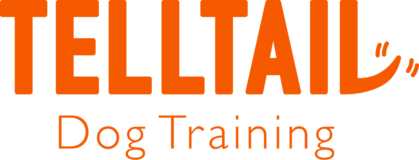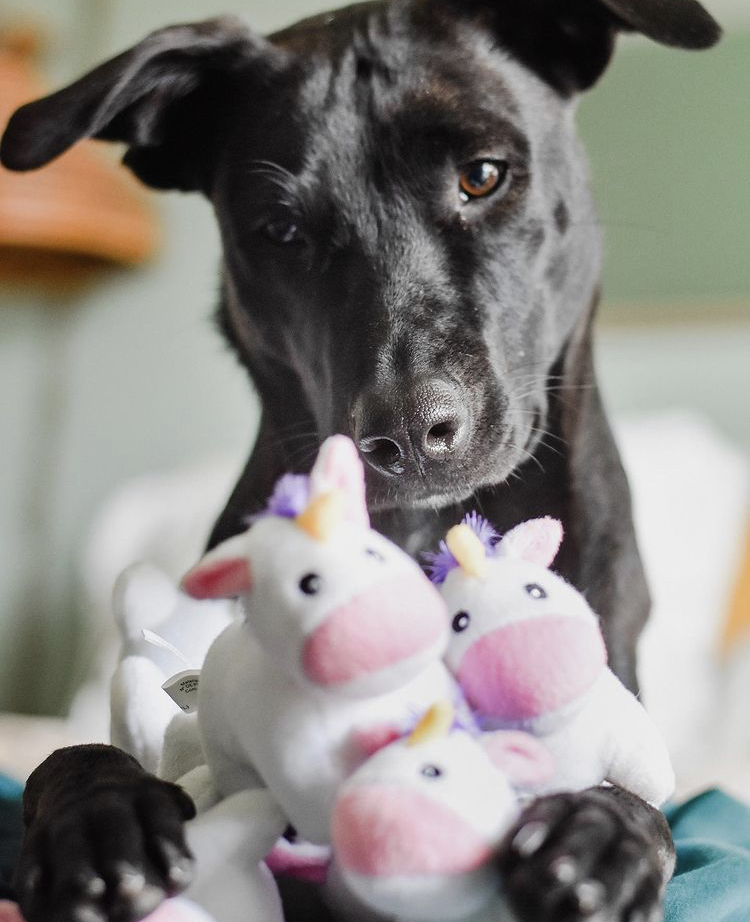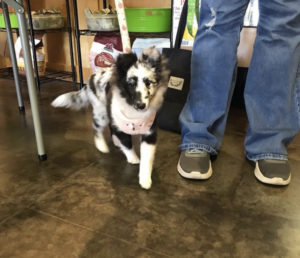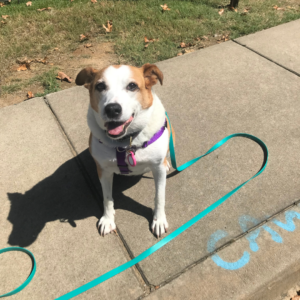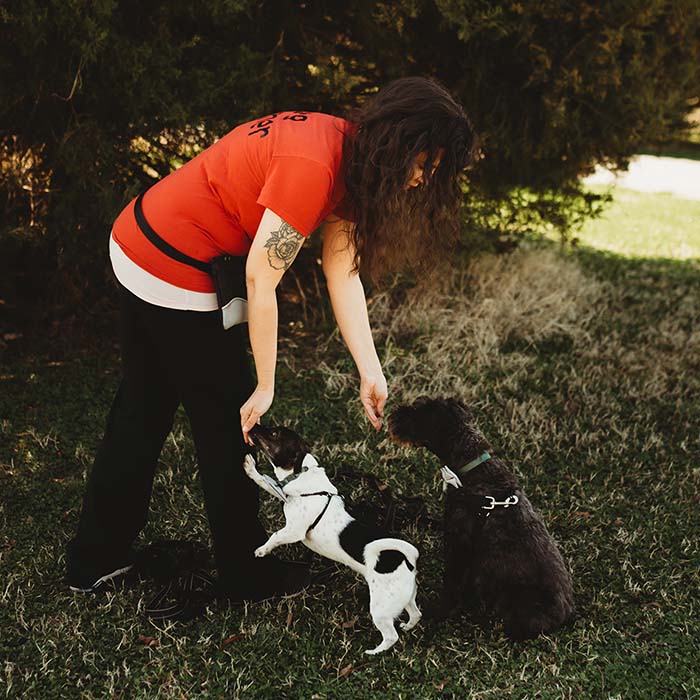Bindi’s Bucket List, based in Ontario, Canada, was just supposed to be a small Instagram account documenting Taylor McDonald and Joe’s two rescue dogs.
They’d adopted Bindi and Rosie as young puppies within a year of each other. Bindi was nervous, and they used Kongs to to crate train her. “We didn’t want her just roaming the house when we were working. We wanted her to be safe,” Taylor explained. “She took to it very, very well. It was very much her safe space. So it was just such a habit to give her a Kong before we crated her and it became such a positive thing for her that when it was around the time we were leaving for work, she would already be sitting in her crate.”
They hadn’t realized that Kongs were enrichment. “I think that’s what a lot of people are finding now,” Taylor said. “Now, people are thinking about enrichment and what it means for dogs more so than, ‘I’m just gonna give my dog a peanut-butter-stuffed Kong because that’s what we do when we have dogs.’”

And they hadn’t realized that people were looking for inspiration and other ways to enrich their dogs’ lives. Taylor loves charcuterie and, one day, she posted a dog-inspired version.
It went viral overnight. “So what originally started as just a way for us to track our rescues’ progress so that the rescue that we got our dogs from could see Bindi and Rosie grow, took off as soon as I posted a Kong plating photo almost as a joke,” Taylor explained. “I love doing charcuterie and stuff for our friends and family, obviously pre-COVID when we could have get-togethers and everything. I jokingly posted one of a Kong because I had been looking at all different things you can use inside your Kong besides peanut butter, and that just went haywire overnight. TikTok is obviously a newer kind of beast. I’m still trying to get the hang of that one, but with TikTok, we had just started it, and the beginner’s guide to enrichment went off and overnight, we had 75,000 followers. I was just shocked. Still am shocked that it’s such a weird space but it’s awesome in the same breath that people are so interested in it.”
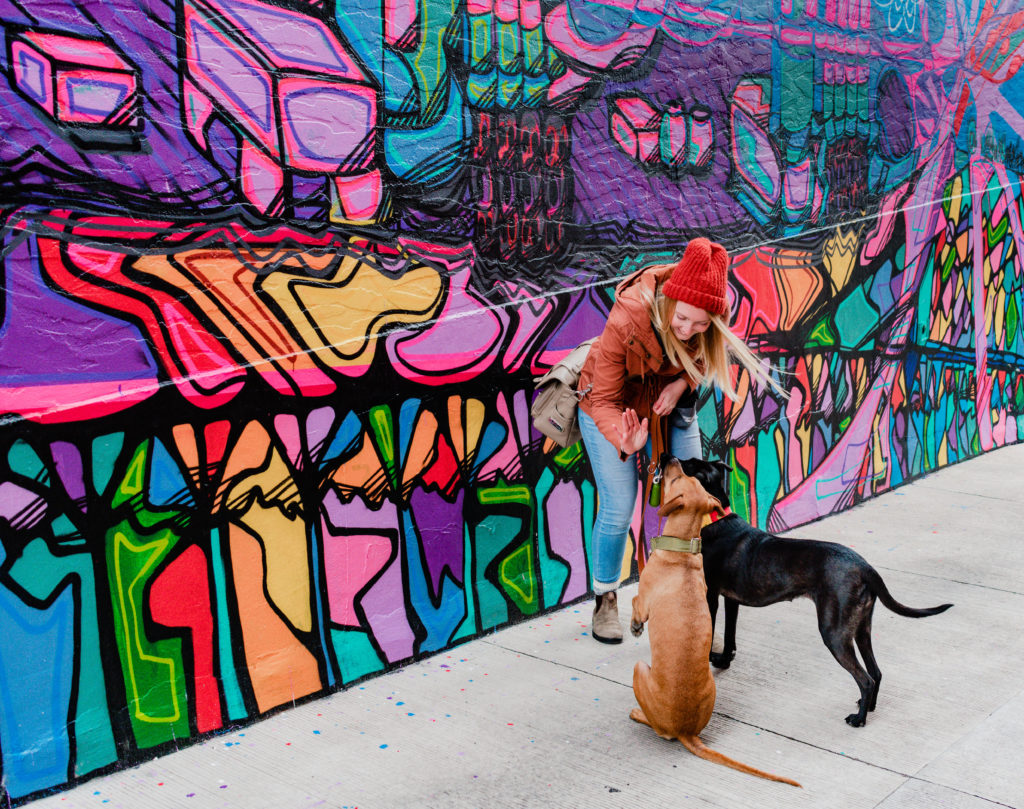
There are lots of ways to define enrichment. Some call it bonus activities, or anything extra outside of a dog’s normal day-to-day activities. Some define it as ways to engage with a dog using actions they’re bred to do. For hounds, that may mean using their nose for scent work or sniffing out treats. For terriers, that may mean chasing a flirt pole. For herding dogs, maybe it’s a herding ball in the backyard. The equivalent for humans may mean reading a book or watching a television show. For dogs, it includes their normal inclinations that humans don’t always let them indulge, like chewing, chasing, sniffing, digging, shredding, plucking, and licking. “Enrichment is essentially when we’re providing a positive outlet for our dog’s innate needs,” Taylor shared.
Erika Gonzalez is a certified dog trainer and the owner of From Dusk Till Dog, based in New Jersey. She has two dogs herself, Jade, who is ten, and Freddie, who is seven. “I love doing enrichment with them,” Erika shared. “They get that on a regular basis every single day. I just have it be a part of our lives. I have two senior dogs now and they get tons of enrichment. I’ve always made it a part of their lives.”
She encourages simple activities. “I think enrichment can be easy,” Erika said. “It doesn’t need to be something extravagant. It doesn’t need to be something that lasts an hour. It could be as simple as putting some of your dog’s dry food in a towel and rolling it up into a little doggie burrito and having them figure it out. … It could be egg cartons. So I save egg cartons and paper towel rolls and toilet paper rolls and cardboard boxes and even that brown paper bag type of paper that comes in the boxes. I wrap chews in there. Your dental treat that you give your dog every day, wrap it up in there and hide it somewhere. You can hide stuff around your house. Just hide a couple treats or a couple of pieces of food. Have your dog go search and send them on a food search. You can do toys like hideaway toys or hiding toys around the house and having your dog go find his favorite toy that you put a name to it and have them go search for it. There’s tons of ways to do it.”
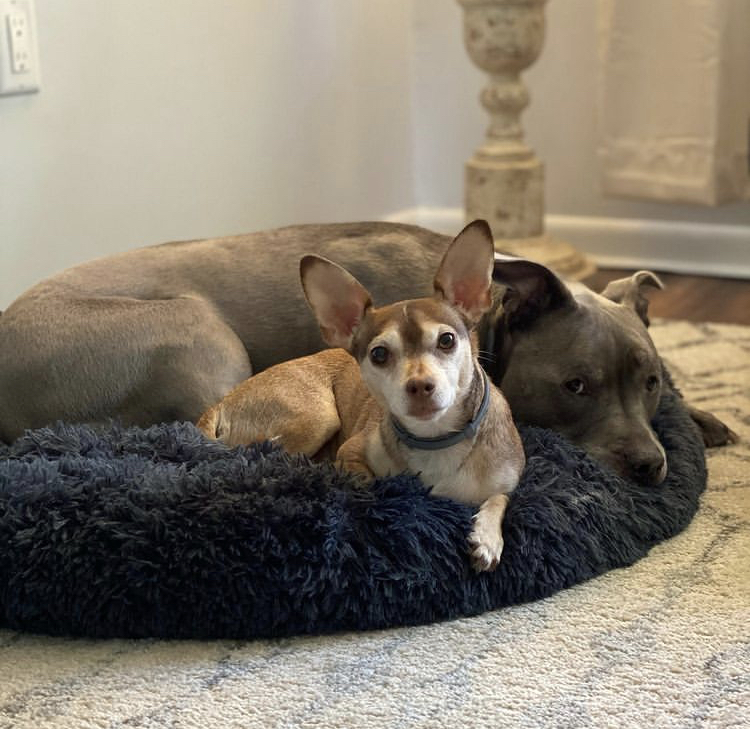
She also encourages decompression walks. “That just means going somewhere with your dog that’s not the block you go around every single day and just letting them be somewhere,” Erika shared. “An empty parking lot. A park. A field. A playground no one’s using. … Make it work. Whatever you can try to do near you to bring your dog on a little bit of a longer leash and just let them kind of do their thing. There’s no structure. There’s no ‘You gotta walk good, you gotta look at me.’ It’s just both of you, human and dog, take a moment to just decompress because lord knows we all need that right now more than ever. So I just wanted to say it can be very simple. It could be as simple as going on a decompression walk.”
Erika cautions against trying to make enrichment activities last too long, as it should be fun for the dog. “I’m all for reasonable ways to extend it, but we also don’t want to get to a point where it’s going to frustrate the dog,” she shared. “I think there’s a fine line between enrichment and then it’s frustrating the heck out of the dog … We want it to work for us, so it should be happy and fun for the dog, but that’s what we want to be mindful of.”
Every dog is going to benefit from a different type of enrichment protocol, much like humans require different types of exercise and activities, Erika explained. “Some dogs need more, some dogs need less,” she said. “People ask me all the time, ‘How long are your decompression walks with Jade and Freddy?’ And I’m like, ‘My number might be different than what your number is going to be for your dog.’ So, you know, for them a good half hour, 45 minutes is perfect. They’re fine for the whole day. Sometimes we get an hour and they’re very fine.”
She often recommends to clients to take a few weeks of data collection on what works best. “I think spending some time and figuring it out is going to save you time in the long run,” Erika shared. “A lot of times what people want for training or how their dog’s gonna respond to things is the version of six-pack abs overnight and I’m like, ‘We need to just be okay with a five-pound weight loss.’”
There are a lot of free resources online that are helpful when getting started. Taylor admins Canine Enrichment, a Facebook group. “I highly recommend it to people who are looking for just a baseline to start with enrichment,” Taylor said. “It is an amazing group with an amazing set of admins. I’ve learned so much from Shay Kelly, who started the whole group and has a book called Canine Enrichment and it’s one of those things that once you realize the amount of enrichment that you can provide your dog for little to no money, and also it doesn’t have to be hard for you to put together, I find that it’s hard to stop.”
And dog owners are realizing the benefits more and more. “I think people are realizing the effect that it has on their dogs and also on themselves,” Taylor shared. “Because when we have happier dogs, we have happier owners and when our dogs are behaving better, it’s obviously going to make everyone in the house happier as well. So once we started on the enrichment train, it honestly kept chugging along and I found myself online until the wee hours in the morning looking up every study that I could because I just had to know more. And it’s not like enrichment is a new thing, either. This has been around forever, especially with concepts such as like the contrafreeloading concept, and you see enrichment in many captive species and animal programs like at the zoo, for example.”
Contrafreeloading is the concept that, when given a choice, dogs will pick the food option that requires effort, like a snufflemat, over the food simply in a bowl.
The benefits are easy to see. “I can see the change of their body language,” Taylor shared. “Especially with snuffle mats–I’m a huge snuffle mat fan–it’s like watching my dogs do a sigh with their body language. They instantly have less tense posture. Their tails are going. You can hear their little noses go. They have soft ears. They’re just at ease and it’s very easy to pick up on when you start to know what visual cues you need to look for. I also notice it a lot in their sleeping routines as well. They’re zonked. They’re tired because they’ve been working their brain. … You can see the positive impact on them for sure and you can see the difference when they don’t have it because they get into more trouble. They’re looking for things to do.”
As on how to start, it can be simple and inexpensive. “Start with the bare bones,” Taylor recommends. “You don’t have to make it super expensive. You don’t have to make it super elaborate. Just start with what you know. If there were three things that you could buy on the market that I would suggest, it would be three toys that provide different aspects of canine enrichment. For example, a classic Kong. Easy to find. They’re pretty much available worldwide, so wherever you are in the world, you should be able to find a classic Kong or something very similar. Then I like to say something like a Kong wobbler or something that moves moves around that treats can come out of so that allows you to have something that is also a little bit active for enrichment. … And then I like to suggest something that is a more of a calming form of enrichment. So something like a snuffle mat or a lick mat, and you don’t even have to purchase a snuffle mat to see if your dog likes it. I have some towel puzzles that are super easy to put together in our reels. They’re also on our blog and our TikTok. I made sure they were on pretty much every social media we have. They’re super easy to put together. All you need is an old towel. It takes two seconds and usually it’s a huge hit with every dog. … But start very easy. Never forget to offer help for your dog, especially if starting out. It’s not a bad thing to offer help. Some people think, ‘Oh, if I offer help, will that discourage my dog or make them dependent on me?’ But when starting out, never hesitate to offer help and always make it easier if your dog is looking frustrated. … We don’t want to cause frustration so starting at the bare bones, making it very easy and then working your way up will help set your dog up for success and then you can start getting a little bit more funky as time goes on and you realize what your dog likes and then the sky is the limit. You can kind of take off in any direction you want.”
Enrichment Quick Guide (TL:DR)
So what is it? Enrichment is any natural dog behavior like licking, digging, chewing, plucking, shredding, herding, chasing, and sniffing. A dog’s breed can give us clues as to what they enjoy the most, but dogs are also individuals and may enjoy different things. The most broad categories are environment, cognitive, and social.
Why do we need it? When we take dogs out of their natural habitats, like herding sheep on a farm, or chasing birds in the forest, and we put them in our homes and expect them to be happy with just a walk or some time at the dog park, we often see an increase in behaviors we find undesirable, like shredding or chewing or digging. When we provide natural outlets that keep our furniture, homes, and dogs safe, we see a decrease in problematic behaviors and an increase in rest and calm in our dogs.
Where do we start? Start small. Research Instagram hashtags, like #CanineEnrichment or #ForceFreeDogTrainer. Follow Instagram accounts like Bindi’s Bucket List, From Dusk Till Dog, Dog Minded, and A Canine Affinity. Start with a kibble or treat scatter in the backyard. Grab a classic Kong, a Kong Wobbler or something else that moves around and dispenses treats, and a snuffle mat or lick mat. For inexpensive options, try some towel folding for meals. Hide treats around the house. Remember to keep things easy and fun and see what your dog enjoys.
Isn’t it supposed to be challenging? No, it’s supposed to be enriching for the dog, and the dog determines what is enriching. Going quickly isn’t an indicator that it isn’t enriching. Maybe the dog needs a snuffle box or some different stations. Maybe the dog needs some structured time for a nap.
What if my dog gains weight? Erika Gonzalez recommends using their food for training, avoiding a big dinner if you just did training, and using their food for enrichment. There’s a whole movement around the hashtag #DitchTheBowl, which suggest throwing out the bowl for mealtimes completely and moving towards enrichment instead. Bindi’s Bucket List also has a great article on their website about non-food enrichment activities.
